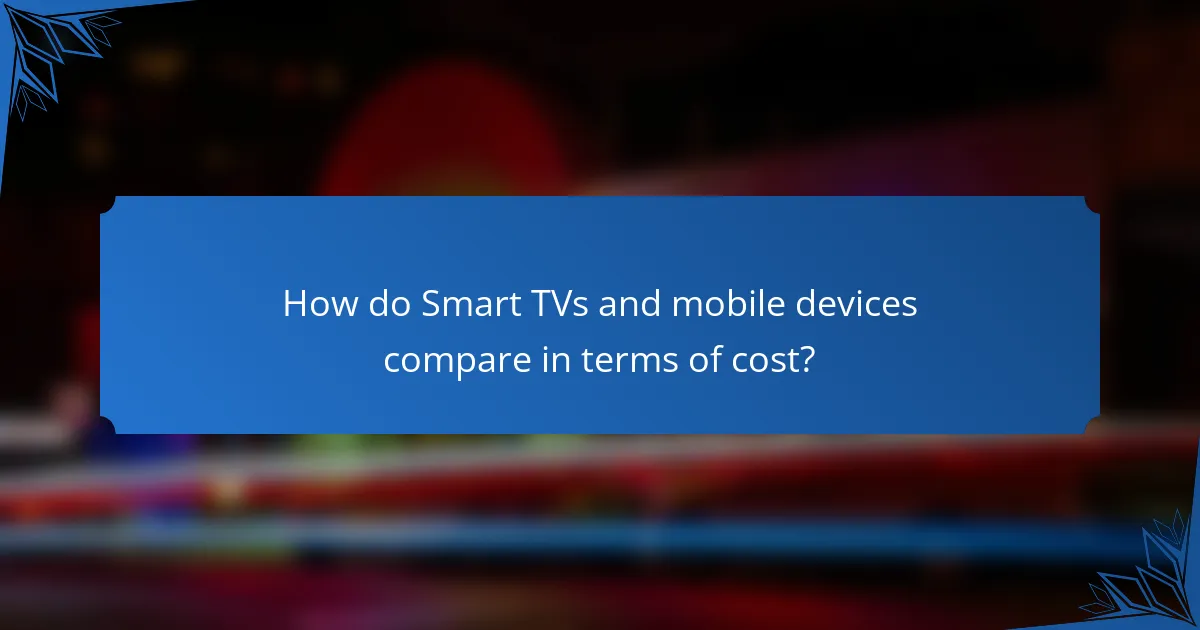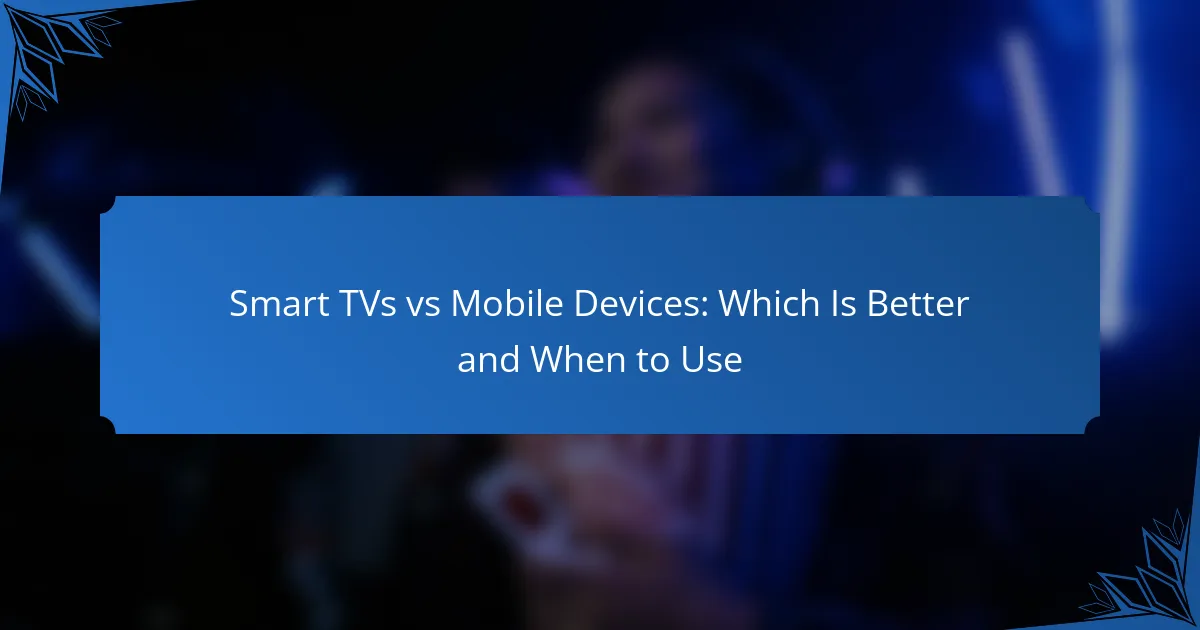When it comes to streaming content, the choice between Smart TVs and mobile devices largely depends on your viewing preferences and lifestyle. Smart TVs provide a larger screen and superior sound quality, making them perfect for home entertainment and immersive experiences. In contrast, mobile devices offer unmatched portability, allowing users to enjoy their favorite shows and movies on the go. Understanding the strengths of each option can help you determine the best fit for your needs.

Which is better for streaming in urban areas?
In urban areas, Smart TVs are often better for streaming due to their larger screens and enhanced viewing experience. However, mobile devices excel in portability, allowing users to stream content anywhere, making the choice dependent on the user’s lifestyle and preferences.
Smart TVs offer larger screens
Smart TVs provide a significantly larger screen size compared to mobile devices, typically ranging from 32 inches to over 75 inches. This size enhances the viewing experience, making it ideal for watching movies, sports, or gaming with friends and family.
When streaming in a shared living space, a larger screen allows for better visibility from different angles, accommodating more viewers comfortably. This is particularly beneficial in urban apartments where space may be limited but social gatherings are common.
Mobile devices provide portability
Mobile devices, such as smartphones and tablets, offer unmatched portability, allowing users to stream content wherever they go. This is especially useful for urban dwellers who commute or travel frequently, as they can enjoy their favorite shows on public transport or during breaks.
While Smart TVs are stationary, mobile devices can easily fit into bags and pockets, making them perfect for on-the-go entertainment. Users can also switch between devices seamlessly, starting a show on a Smart TV and continuing on a mobile device without interruption.
Smart TVs support higher resolutions
Many Smart TVs support high-definition (HD) and ultra-high-definition (UHD) resolutions, providing a clearer and more detailed picture. This is particularly important for streaming services that offer 4K content, enhancing the overall viewing experience.
In contrast, while many mobile devices also support HD, their smaller screens may not fully utilize the benefits of higher resolutions. For viewers who prioritize image quality, Smart TVs are the better choice, especially for larger viewing distances typical in urban settings.
Mobile devices allow for on-the-go access
Mobile devices facilitate on-the-go access to streaming services, allowing users to watch content anytime and anywhere. This flexibility is crucial for urban residents who may have busy schedules and prefer to consume media during commutes or while waiting in line.
Additionally, many streaming apps are optimized for mobile use, offering features like offline downloads, which can be invaluable in areas with limited internet connectivity. This capability ensures that users can enjoy their favorite shows without worrying about data limits or Wi-Fi availability.

When should you choose Smart TVs over mobile devices?
Smart TVs are ideal for larger viewing experiences, particularly in settings where screen size and sound quality enhance the enjoyment of content. They are preferable for home cinema, gatherings, and gaming due to their ability to deliver immersive experiences that mobile devices cannot match.
For home cinema experiences
Smart TVs provide a cinematic experience with larger screens and superior sound systems compared to mobile devices. When watching movies or shows, the enhanced resolution and audio quality can significantly improve immersion, making it feel like you’re in a theater.
Consider a Smart TV with 4K resolution and HDR capabilities for the best experience. This setup can elevate the visual quality of films and series, allowing you to appreciate details that smaller screens might miss.
When hosting gatherings
For social events, Smart TVs are better suited for displaying content to larger groups. Whether it’s a sports game, a movie night, or a presentation, the bigger screen ensures everyone can see and enjoy the experience together.
Ensure your Smart TV is connected to a reliable streaming service and has sufficient sound output to fill the room. This setup minimizes the need for multiple mobile devices and creates a more cohesive viewing experience.
For gaming on larger displays
Smart TVs offer a more engaging gaming experience due to their larger displays and often lower input lag compared to mobile devices. This is particularly beneficial for multiplayer games or immersive single-player experiences where visual detail and screen size enhance gameplay.
Look for a Smart TV with a high refresh rate and gaming mode settings to optimize performance. This can make a significant difference in responsiveness and overall enjoyment during gaming sessions.

What are the advantages of Smart TVs?
Smart TVs offer several advantages, including integrated streaming services, superior sound quality, and the ability to connect with smart home devices. These features enhance the viewing experience, making Smart TVs a popular choice for home entertainment.
Integrated streaming apps
Smart TVs come with built-in streaming applications, allowing users to access platforms like Netflix, Hulu, and Amazon Prime Video directly from the TV. This eliminates the need for external devices, simplifying the setup and reducing clutter.
Most Smart TVs support a wide range of apps, often including popular services and even local channels. Users can easily download additional apps from their TV’s app store, ensuring they have access to the latest content.
Better sound quality
Smart TVs typically feature enhanced audio systems compared to mobile devices, providing a more immersive viewing experience. Many models include built-in speakers that deliver clearer dialogue and richer sound, making movies and shows more enjoyable.
For those seeking even better audio, Smart TVs can connect to external sound systems or soundbars via Bluetooth or HDMI. This flexibility allows users to customize their audio setup based on their preferences and room acoustics.
Smart home integration
Smart TVs can serve as a central hub for smart home devices, allowing users to control lights, thermostats, and security systems directly from the TV interface. This integration streamlines home automation, making it easier to manage multiple devices.
Many Smart TVs are compatible with popular smart home ecosystems, such as Google Home or Amazon Alexa. This compatibility enables voice control and automation routines, enhancing convenience and user experience.

What are the advantages of mobile devices?
Mobile devices offer several advantages, including their convenience, personalized viewing experiences, and access to a broader range of content. These features make them a popular choice for users who prioritize flexibility and tailored entertainment options.
Convenience and portability
Mobile devices are designed for on-the-go use, allowing users to watch content anywhere, whether at home, on public transport, or while traveling. Their lightweight and compact nature makes them easy to carry, fitting comfortably in bags or pockets.
This portability means you can enjoy your favorite shows or movies during commutes or while waiting in line, maximizing your downtime. The ability to access content from virtually anywhere is a significant advantage over traditional TVs.
Personalized viewing experiences
Mobile devices enable highly personalized viewing experiences through customizable apps and streaming services. Users can create profiles, receive tailored recommendations, and curate their own playlists based on preferences.
This level of personalization enhances user engagement, as viewers can easily find content that aligns with their tastes, whether it’s niche documentaries or popular series. Additionally, features like offline downloads allow for uninterrupted viewing even without internet access.
Access to a wider range of content
Mobile devices provide access to a vast array of content options, including streaming platforms, social media, and user-generated videos. This diversity is often broader than what is available on traditional TV channels.
With mobile devices, users can explore international content, niche genres, and exclusive releases that may not be available on standard cable packages. This flexibility allows for a richer entertainment experience tailored to individual interests and viewing habits.

How do Smart TVs and mobile devices compare in terms of cost?
Smart TVs generally have higher upfront costs compared to mobile devices, but the total cost of ownership can vary based on usage patterns and additional expenses like data plans. Understanding these differences can help you make an informed decision based on your viewing habits and budget.
Smart TVs have higher upfront costs
Smart TVs typically range from a few hundred to several thousand dollars, depending on the size, brand, and features. For example, a mid-range Smart TV might cost around $500, while premium models can exceed $2,000. This initial investment is significantly higher than most mobile devices, which can be acquired for as low as $100 to $1,000.
When purchasing a Smart TV, consider additional costs such as installation and accessories like sound systems or mounts. These can add up quickly, making the total initial investment even higher.
Mobile devices may incur data charges
While mobile devices often have lower upfront costs, they can lead to ongoing expenses through data charges. Depending on your mobile plan, streaming content on a smartphone or tablet can consume significant data, potentially resulting in overage fees. Many users may face monthly bills that vary widely based on their usage, with some plans costing $30 to $100 or more.
To mitigate these costs, consider using Wi-Fi whenever possible for streaming, or look for unlimited data plans that fit your budget. This can help you avoid unexpected charges while enjoying content on mobile devices.
Long-term savings with Smart TVs
Despite the higher initial costs, Smart TVs can lead to long-term savings, particularly if you frequently watch streaming services. Many Smart TVs come with built-in apps that allow you to access content without needing additional devices, reducing the need for subscriptions to cable services.
Additionally, Smart TVs often provide better picture quality and larger screens, enhancing the viewing experience. This can lead to fewer trips to the cinema and lower entertainment costs in the long run, especially for families or avid movie watchers.



